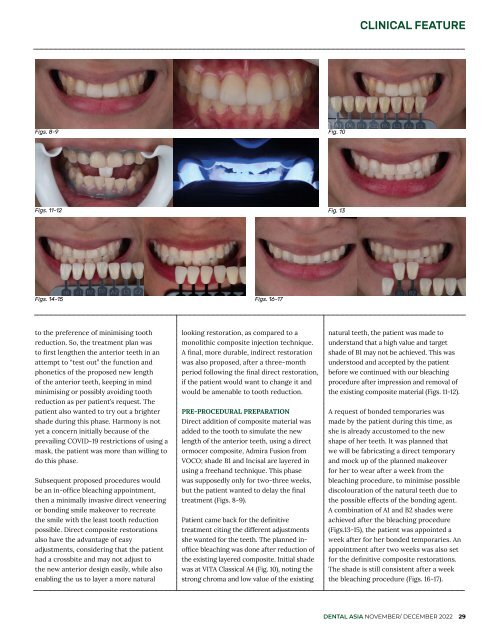Dental Asia November/December 2022
For more than two decades, Dental Asia is the premium journal in linking dental innovators and manufacturers to its rightful audience. We devote ourselves in showcasing the latest dental technology and share evidence-based clinical philosophies to serve as an educational platform to dental professionals. Our combined portfolio of print and digital media also allows us to reach a wider market and secure our position as the leading dental media in the Asia Pacific region while facilitating global interactions among our readers.
For more than two decades, Dental Asia is the premium journal in linking dental innovators and manufacturers to its rightful audience. We devote ourselves in showcasing the latest dental technology and share evidence-based clinical philosophies to serve as an educational platform to dental professionals. Our combined portfolio of print and digital media also allows us to reach a wider market and secure our position as the leading dental media in the Asia Pacific region while facilitating global interactions among our readers.
Create successful ePaper yourself
Turn your PDF publications into a flip-book with our unique Google optimized e-Paper software.
CLINICAL FEATURE<br />
Figs. 8-9<br />
Fig. 10<br />
Figs. 11-12<br />
Fig. 13<br />
Figs. 14-15<br />
Figs. 16-17<br />
to the preference of minimising tooth<br />
reduction. So, the treatment plan was<br />
to first lengthen the anterior teeth in an<br />
attempt to “test out” the function and<br />
phonetics of the proposed new length<br />
of the anterior teeth, keeping in mind<br />
minimising or possibly avoiding tooth<br />
reduction as per patient’s request. The<br />
patient also wanted to try out a brighter<br />
shade during this phase. Harmony is not<br />
yet a concern initially because of the<br />
prevailing COVID-19 restrictions of using a<br />
mask, the patient was more than willing to<br />
do this phase.<br />
Subsequent proposed procedures would<br />
be an in-office bleaching appointment,<br />
then a minimally invasive direct veneering<br />
or bonding smile makeover to recreate<br />
the smile with the least tooth reduction<br />
possible. Direct composite restorations<br />
also have the advantage of easy<br />
adjustments, considering that the patient<br />
had a crossbite and may not adjust to<br />
the new anterior design easily, while also<br />
enabling the us to layer a more natural<br />
looking restoration, as compared to a<br />
monolithic composite injection technique.<br />
A final, more durable, indirect restoration<br />
was also proposed, after a three-month<br />
period following the final direct restoration,<br />
if the patient would want to change it and<br />
would be amenable to tooth reduction.<br />
PRE-PROCEDURAL PREPARATION<br />
Direct addition of composite material was<br />
added to the tooth to simulate the new<br />
length of the anterior teeth, using a direct<br />
ormocer composite, Admira Fusion from<br />
VOCO; shade B1 and Incisal are layered in<br />
using a freehand technique. This phase<br />
was supposedly only for two-three weeks,<br />
but the patient wanted to delay the final<br />
treatment (Figs. 8-9).<br />
Patient came back for the definitive<br />
treatment citing the different adjustments<br />
she wanted for the teeth. The planned inoffice<br />
bleaching was done after reduction of<br />
the existing layered composite. Initial shade<br />
was at VITA Classical A4 (Fig. 10), noting the<br />
strong chroma and low value of the existing<br />
natural teeth, the patient was made to<br />
understand that a high value and target<br />
shade of B1 may not be achieved. This was<br />
understood and accepted by the patient<br />
before we continued with our bleaching<br />
procedure after impression and removal of<br />
the existing composite material (Figs. 11-12).<br />
A request of bonded temporaries was<br />
made by the patient during this time, as<br />
she is already accustomed to the new<br />
shape of her teeth. It was planned that<br />
we will be fabricating a direct temporary<br />
and mock up of the planned makeover<br />
for her to wear after a week from the<br />
bleaching procedure, to minimise possible<br />
discolouration of the natural teeth due to<br />
the possible effects of the bonding agent.<br />
A combination of A1 and B2 shades were<br />
achieved after the bleaching procedure<br />
(Figs.13-15), the patient was appointed a<br />
week after for her bonded temporaries. An<br />
appointment after two weeks was also set<br />
for the definitive composite restorations.<br />
The shade is still consistent after a week<br />
the bleaching procedure (Figs. 16-17).<br />
DENTAL ASIA NOVEMBER/ DECEMBER <strong>2022</strong> 29


















